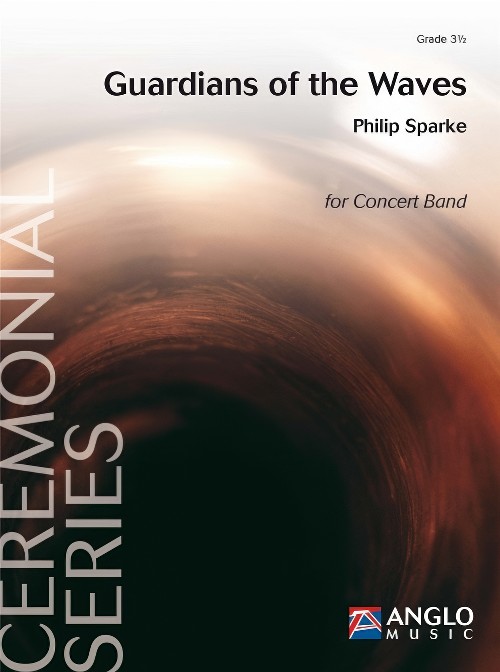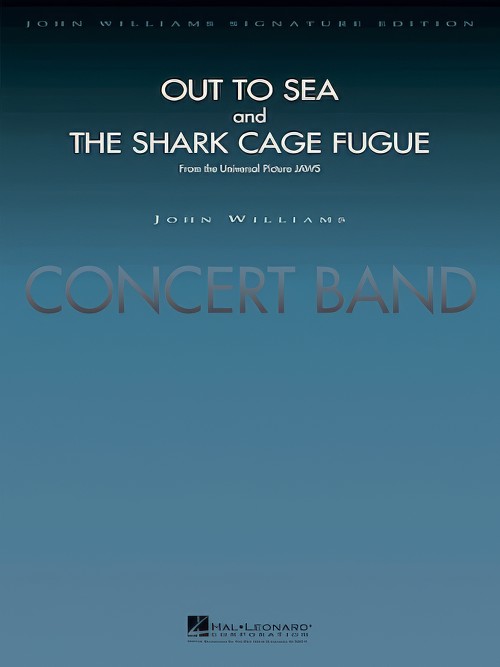Results
-
 £91.99
£91.99Guardians of the Waves (Concert Band - Score and Parts) - Sparke, Philip
Guardians of the Waves was commissioned by the Japan Coast Guard Band to celebrate their 30th anniversary in 2018. They gave the premiere as part of a 30th anniversary concert on November 8th that year. Set in traditional march form, Guardians of the Waves opens with a short introduction, which leads to the main theme, played initially by the brass and then repeated with a florid woodwind descant. The theme is extended and morphs into a second theme, first played tutti and then quietly repeated by bassoon, tenor sax and euphonium. This leads to a conventional 'bass strain', played twice with varying accompaniments. A quieter trio section follows, delicately scored and featuring the tenor instruments of the band. Taken up by the full band, this leads back to a recall of the introduction and a return to the main two themes, which lead to a triumphal close. Duration: 4.00
Estimated dispatch 7-14 working days
-
 £26.99
£26.99Out to Sea & The Shark Cage Fugue (from Jaws) (Concert Band - Score only) - Williams, John - Bocook, Jay
Referring to the 1975 blockbuster Jaws, director Steven Spielberg states that John Williams' music "was clearly responsible for half the success of the movie." This suite features two of the signature musical sequences. In "Out to Sea," the trio of shark hunters led by police chief Martin Brody (played by Roy Scheider) heads into open water to find the menacing beast. This is followed by the "Shark Cage Fugue," a classically inspired and sophisticated accompaniment to a tense underwater scene in which Hooper (portrayed by Richard Dreyfuss) comes face-to-face with the great white in an all-too-fragile suspended cage.
Estimated dispatch 7-14 working days
-
 £204.99
£204.99Out to Sea & The Shark Cage Fugue (from Jaws) (Concert Band - Score and Parts) - Williams, John - Bocook, Jay
Referring to the 1975 blockbuster Jaws, director Steven Spielberg states that John Williams' music "was clearly responsible for half the success of the movie." This suite features two of the signature musical sequences. In "Out to Sea," the trio of shark hunters led by police chief Martin Brody (played by Roy Scheider) heads into open water to find the menacing beast. This is followed by the "Shark Cage Fugue," a classically inspired and sophisticated accompaniment to a tense underwater scene in which Hooper (portrayed by Richard Dreyfuss) comes face-to-face with the great white in an all-too-fragile suspended cage.
Estimated dispatch 7-14 working days
-
 £115.00
£115.00DIVERTIMENTO FOR BAND (Concert Band) - Woolfenden, Guy
Includes:I. ToccataII. AubadeIII. ScherzoMany of the principal musical ideas for Divertimento for Band are derived from music composed for a documentary film called Country Camera, which celebrated the work of the earliest photographers who recorded a way of life which vanished at the outset of the first World War.The three movements are played without a break. The Toccata pits a four-note motif (which always appears with its mirror image) against several other derived ideas, including a sour horn (later trumpet) figure, a tiny lyrical passage initiated by a solo alto saxophone, and a more gentle, but still staccato episode. Many polytonal devices keep the four-note motif active. The Aubade contrasts a lyrical pastorale, initiated by a solo flute, with a more intense central section on the brass. The Scherzo finale has three main ideas; a tune for principal bassoon and euphonium of a playful child-like nature, a rushing figure for the woodwinds later developed by the full band, and a solo for trumpet and clarinet, involving a descending scale and a lyrical wide-leaping recovery. The exuberant coda is derived from themes from the previous two movements.The world premiere of Divertimento for Band was given at the conference of the World Association for Symphonic Bands and Ensembles in Killarney on 13th July 2007 conducted by the composer, and is affectionately dedicated to Keith Allen, Jayne Rollason and Birmingham Symphonic Winds. -GW
Estimated dispatch 7-14 working days
-
 £64.95
£64.95WHEREVER YOU ARE (Concert Band) - Mealor, Paul - Stubbs, Duncan
Commissioned by Gareth Malone for Series Four of BBC TV's 'The Choir' and first performed by Malone and The Military Wives Choir as part of The Royal British Legion's Festival of Remembrance at the Royal Albert Hall on 12 November 2011, in the presence of Her Majesty The Queen. The text is taken from poems, letters and prayers written by the Military Wives, selected and adapted by Paul Mealor, and a passage from the Book of John. Selling a staggering 556,000 copies in the week leading up to Christmas, more than the rest of the Top 12 combined, Wherever You Are became the UK's Official Christmas No. 1 of 2011. A brass band version is also available. A contribution from the sales of the sheet music will be donated to the two nominated charities: The Royal British Legion and SSAFA Forces Help.
Estimated dispatch 7-14 working days
-
 £204.00
£204.00The Light of Resistance - Franco Cesarini
Franco Cesarini was commissioned to write The Light of Resistance by the Filarmonica di Villadossola APS (Piedmont, Italy) for its 125th anniversary. The Villadossola revolt was an uprising that took place in November 1943 in the homonymous municipality during World War II. The partisans, with the support of local workers, managed to temporarily liberate the town from nazi-fascist forces. It was one of the first acts of armed resistance against the German occupation in Italy but was harshly repressed by nazi-fascist troops who regained control of the territory. Although it was suppressed, the uprising remained a symbol of courage and determination.The slow introduction of the composition creates an atmosphere of latent tension, which gradually intensifies until it explodes in a rapid movement, symbolizing the struggle. Two contrasting musical themes collide, embodying the conflict between opposing forces. In the central section, a prayer rises delicately, then evolves into a heroic parade celebrating the temporary triumph of the revolt. However, this victory is fleeting; dissonant harmonies interrupt the scene, representing the brutal repression of the insurrection. In the finale, the heroic theme reemerges, evoking sacrifice as a spark of unshakeable hope. A moment of contemplation closes the composition, honouring the lives broken and reaffirming hope for a future of peace and regained freedom.The premiere of The Light of Resistance took place on 30th March, 2025 in Villadossola, performed by the Filarmonica di Villadossola, Franco Cesarini conductor.
Estimated dispatch 7-14 working days
-
 £74.00
£74.00Galop - Amilcare Ponchielli
La Gioconda, with a libretto by Arrigo Boito, is the most successful theatrical work by Amilcare Ponchielli (1844-1886). In this work there are two dance pieces: the Furlana at the conclusion of the 1st act and the Danza delle ore in the 3rd act. The Dance of the Hours has a precise choreographic outline: it is a masked ball which includes the "hours" of dawn, day, evening and night successively, and ends with a wild finale of galop. The latter is a sort of fast polka, in binary rhythm and unbridled pace. A French variant of it is the can-can. The finale in galop time of the Dance of the Hours recalls certain playful dances by the composer Jacques Offenbach, such as the famous Can-can that concludes the overture of the operetta Orphe au enfers.
Estimated dispatch 7-14 working days
-
 £60.99
£60.99The Banks of Green Willow - George Butterworth
Written by British composer George Butterworth in 1913, this classic work is based on two folk songs - The Banks of Green Willow and Green Bushes (the latter also appearing in works by Grainger and Vaughan Williams). Butterworthdied in World War I at the age of 31, and this composition remains his most popular, regarded as an anthem for Unknown Soldiers. Here is a masterful setting for winds adapted by Robert Longfield. Dur: 3:50
Estimated dispatch 7-14 working days
-
 £94.99
£94.99Children's Oak - Thierry Deleruyelle
Children's Oak was commissioned by the wind band from Beauquesne, France. This solemn work pays homage to a city particularly affected by the two World Wars and is inspired by the knowledge that the city of Beauquesne needed to recover from these terrible episodes in its history. The title has its origin in the roots of the word "Beauquesne", the beautiful oak tree. It is a beautiful slow piece for your concert, or as a resource to work on phrasing and intonation, or alternatively as a warm up piece.
Estimated dispatch 7-14 working days
-
 £149.40
£149.40The Battle of the Hats - Øystein Sjøvaag Heimdal
The word svimesltt, which is the title of this piece in Norwegian, has two meanings. One meaning is "knocked out", whilst the other, "sltt", means a folk melody/dance.Svimesltt is one of several folk dances, all of them with humorous titles, originally written by ystein Olsen Vadsten. Norwegian culture is the basis for these dances, both rhythmically and melodically. The accompaniment has brought this funpiece into the 21st Century.When it comes to Svimesltt, it is the traditional dance "halling" that is the inspiration. Halling is a rather wild dance, where the man tries to win the heart of a lady by attempting to kick a hat off a stick,held up in the air. This iswhere "The Battle of the Hats" gets its distinctive name A truly Norwegian tradition.The composer wanted to write a "crazy" melody, which highlights how "knocked out" a man can be by love, as he tries to win the chosen ones heart.
Estimated dispatch 7-14 working days
